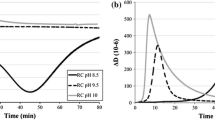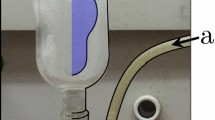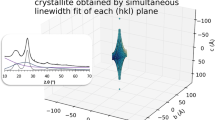Abstract
Atomic force microscopy in liquid environments (L-AFM) became a state of the art technique in the field of enzymatic cellulose degradation due to its capability of in situ investigations on enzymatic relevant scales. Current investigations are however limited to few substrates like valonia cellulose, cotton linters and processed amorphous cellulose as only these show required flatness and purity. Structurally monophasic, these substrates confine conclusions regarding enzymatic degradation of mixed amorphous–crystalline substrates as commonly found in nature. To exploit the full potential of the technique, cellulose substrates with multiphase properties, flat topology and purity are therefore absolutely required. In this study we introduce a special preparation route based on highly crystalline Avicel PH101® cellulose and the ionic liquid 1-butyl-3-methylimmidazolium chloride as dissolution reagent. As comprehensively shown by atomic force microscopy, wide angle X-ray scattering, Raman spectroscopy and electron microscopy, the developed material allows precise control of its polymorphic composition by means of cellulose types I and II embedded in an amorphous matrix. Together with the tunable composition and flat topology over large areas (>10 × 10 µm2) the material is highly suited for L-AFM studies.







Similar content being viewed by others
Abbreviations
- MACS:
-
Mixed amorphous−crystalline cellulose substrate
- C1β :
-
Cellulose Iβ
- C2:
-
Cellulose II
- Avicel:
-
Avicel PH101®
- BmimCl:
-
1-Butyl-3-methylimmidazolium chloride
- UM:
-
Ultramicrotomy
- L-AFM:
-
Atomic force microscopy in liquid environments
- WAXS:
-
Wide angle X-ray scattering
- TEM:
-
Transmission electron microscopy
- SEM:
-
Scanning electron microscopy
- RS:
-
Raman spectroscopy
- RMS:
-
Root mean square roughness
- FWHM:
-
Full width at half maximum
References
Agarwal U, Reiner R, Ralph S (2010) Cellulose I crystallinity determination using FT-Raman spectroscopy: univariate and multivariate methods. Cellulose 17:721–733. doi:10.1007/s10570-010-9420-z
Ahola S, Turon X, Osterberg M et al (2008) Enzymatic hydrolysis of native cellulose nanofibrils and other cellulose model films: effect of surface structure. Langmuir 24:11592–11599. doi:10.1021/la801550j
Bubner P, Dohr J, Plank H et al (2012) Cellulases dig deep: in situ observation of the mesoscopic structural dynamics of enzymatic cellulose degradation. J Biol Chem 287:2759–2765. doi:10.1074/jbc.M111.257717
Bubner P, Plank H, Nidetzky B (2013) Visualizing cellulase activity. Biotechnol Bioeng 110:1529–1549. doi:10.1002/bit.24884
Chinga-Carrasco G (2011) Cellulose fibres, nanofibrils and microfibrils: the morphological sequence of MFC components from a plant physiology and fibre technology point of view. Nanoscale Res Lett 6:417
Eibinger M, Bubner P, Ganner T et al (2014) Surface structural dynamics of enzymatic cellulose degradation, revealed by combined kinetic and atomic force microscopy studies. FEBS J 281:275–290. doi:10.1111/febs.12594
Fengel D, Jakob H, Strobel C (1995) Influence of the Alkali concentration on the formation of cellulose II. Study by X-ray diffraction and FTIR spectroscopy. Holzforschung 49:505–511. doi:10.1515/hfsg.1995.49.6.505
French AD (2014) Idealized powder diffraction patterns for cellulose polymorphs. Cellulose 21:885–896. doi:10.1007/s10570-013-0030-4
Ganner T, Bubner P, Eibinger M et al (2012) Dissecting and reconstructing synergism: in situ visualization of cooperativity among cellulases. J Biol Chem 287:43215–43222. doi:10.1074/jbc.M112.419952
Himmel ME, Ding S-Y, Johnson DK et al (2007) Biomass recalcitrance: engineering plants and enzymes for biofuels production. Science 315:804–807. doi:10.1126/science.1137016
Igarashi K, Uchihashi T, Koivula A et al (2011) Traffic jams reduce hydrolytic efficiency of cellulase on cellulose surface. Science 333:1279–1282. doi:10.1126/science.1208386
Klemm D, Heublein B, Fink H-P, Bohn A (2005) Cellulose: fascinating biopolymer and sustainable raw material. Angew Chem Int Ed Engl 44:3358–3393. doi:10.1002/anie.200460587
Kocherbitov V, Ulvenlund S, Kober M et al (2008) Hydration of microcrystalline cellulose and milled cellulose studied by sorption calorimetry. J Phys Chem B 112:3728–3734. doi:10.1021/jp711554c
Korayem MH, Ebrahimi N (2011) Nonlinear dynamics of tapping-mode atomic force microscopy in liquid. J Appl Phys 109:084301. doi:10.1063/1.3573390
Kroon-Batenburg LMJ, Bouma B, Kroon J (1996) Stability of cellulose structures studied by MD simulations. Could mercerized cellulose II be parallel ? Biomacromolecules 9297:5695–5699
Lynd LR, Weimer PJ, van Zyl WH, Pretorius IS (2002) Microbial cellulose utilization: fundamentals and biotechnology. Microbiol Mol Biol Rev 66:506–577. doi:10.1128/MMBR.66.3.506-577.2002
Mäki-Arvela P, Anugwom I, Virtanen P et al (2010) Dissolution of lignocellulosic materials and its constituents using ionic liquids—a review. Ind Crops Prod 32:175–201. doi:10.1016/j.indcrop.2010.04.005
Mittal A, Katahira R, Himmel M, Johnson D (2011) Effects of alkaline or liquid-ammonia treatment on crystalline cellulose: changes in crystalline structure and effects on enzymatic digestibility. Biotechnol Biofuels 4:41
Moon RJ, Martini A, Nairn J et al (2011) Cellulose nanomaterials review: structure, properties and nanocomposites. Chem Soc Rev 40:3941–3994. doi:10.1039/c0cs00108b
Nidetzky B, Steiner W, Hayn M, Claeyssens M (1994) Cellulose hydrolysis by the cellulases from Trichoderma reesei: a new model for synergistic interaction. Biochem J 298:705–710
Park S, Baker J, Himmel M et al (2010) Cellulose crystallinity index: measurement techniques and their impact on interpreting cellulase performance. Biotechnol Biofuels 3:10
Rubin EM (2008) Genomics of cellulosic biofuels. Nature 454:841–845. doi:10.1038/nature07190
Schenzel K, Fischer S (2001) NIR FT Raman spectroscopy—a rapid analytical tool for detecting the transformation of cellulose polymorphs. Cellulose 8:49–57. doi:10.1023/A:1016616920539
Schenzel K, Fischer S, Brendler E (2005) New method for determining the degree of cellulose i crystallinity by means of FT Raman spectroscopy. Cellulose 12:223–231. doi:10.1007/s10570-004-3885-6
Swatloski RP, Spear SK, Holbrey JD, Rogers RD (2002) Dissolution of cellose with ionic liquids. J Am Chem Soc 124:4974–4975. doi:10.1021/ja025790m
Tilman D, Socolow R, Foley JA et al (2009) Beneficial biofuels—the food, energy, and environment trilemma. Science 325:270–271. doi:10.1126/science.1177970
Vitz J, Erdmenger T, Haensch C, Schubert US (2009) Extended dissolution studies of cellulose in imidazolium based ionic liquids. Green Chem 11:417–424. doi:10.1039/B818061J
Wang L, Zhang Y, Gao P et al (2006) Changes in the structural properties and rate of hydrolysis of cotton fibers during extended enzymatic hydrolysis. Biotechnol Bioeng 93:443–456. doi:10.1002/bit.20730
Wiley H, Atalla RH (1987) Band Assignments in the Raman spectra of celluloses. Carbohydr Res 160:113–129
Zavrel M, Bross D, Funke M et al (2009) High-throughput screening for ionic liquids dissolving (ligno-)cellulose. Bioresour Technol 100:2580–2587. doi:10.1016/j.biortech.2008.11.052
Zhang H, Wu J, Zhang J, He J (2005) 1-Allyl-3-methylimidazolium chloride room temperature ionic liquid: a new and powerful nonderivatizing solvent for cellulose. Macromolecules 38:8272–8277. doi:10.1021/ma0505676
Acknowledgments
We thank Stefan Mitsche for helping us with WAXS analysis; Stephanie Rosker for helping us with the experiments; Angelina Orthacker, Robert Winkler and Ferdinand Hofer for discussions. Gratitude goes to the Cambridge Crystallographic Data Centre (CCDC) for the ability to use Mercury 3.3 for simulation purposes. Financial support was provided from the Austrian Science Fund FWF (Grant P 24156-B21 to B.N.).
Author information
Authors and Affiliations
Corresponding authors
Additional information
Thomas Ganner and Timothy Aschl have contributed equally to this work.
Rights and permissions
About this article
Cite this article
Ganner, T., Aschl, T., Eibinger, M. et al. Tunable mixed amorphous–crystalline cellulose substrates (MACS) for dynamic degradation studies by atomic force microscopy in liquid environments. Cellulose 21, 3927–3939 (2014). https://doi.org/10.1007/s10570-014-0419-8
Received:
Accepted:
Published:
Issue Date:
DOI: https://doi.org/10.1007/s10570-014-0419-8




